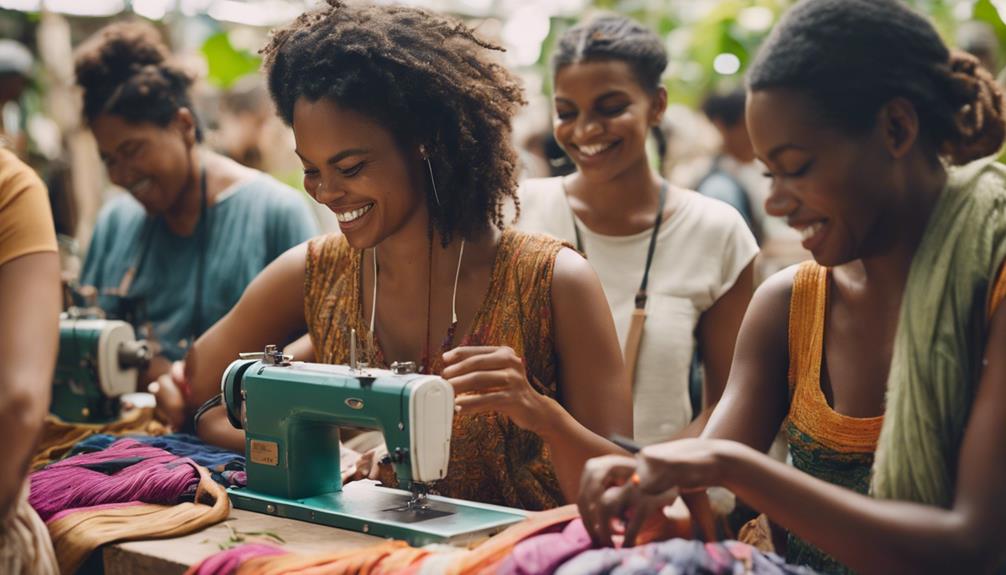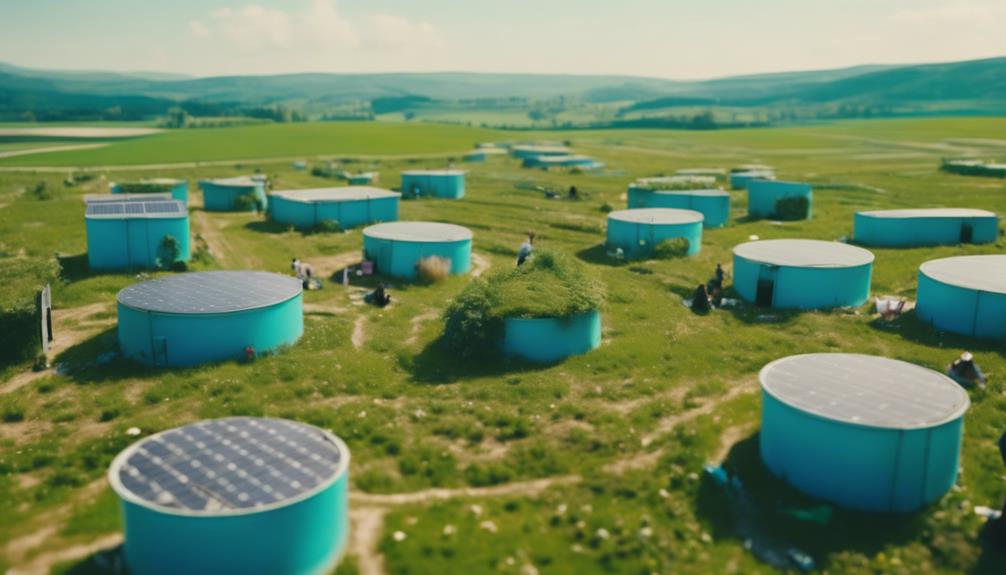You need sustainable fashion to help address the alarming environmental damage caused by the clothing industry. It contributes to 10% of global greenhouse gas emissions and generates significant waste. By opting for sustainable choices, you are promoting ethical labor practices and reducing pollution through biodegradable materials and recycling. Additionally, investing in high-quality garments can save you money over time as they have a longer lifespan and minimize waste. This transition is not only about clothing; it is about fostering a healthier planet for yourself and future generations. Explore further how sustainable fashion can make a significant difference.
Key Takeaways
- Sustainable fashion reduces the fashion industry's significant contribution to global greenhouse gas emissions and water pollution, promoting a healthier planet.
- Ethical practices ensure fair treatment, living wages, and safe working conditions for garment workers, fostering social responsibility.
- Investing in durable, sustainable garments lowers overall spending and waste, benefiting both consumers and the environment.
- Consumer demand for eco-friendly products is rising, indicating a shift towards prioritizing sustainability in purchasing decisions.
Understanding Sustainable Fashion
Sustainable fashion aims to reshape the clothing industry by prioritizing eco-friendly practices and ethical production methods that benefit both the planet and its workers. In a world dominated by fast fashion, it's essential for you to understand the significance of sustainable fashion. This movement emphasizes ethical practices that promote worker welfare while minimizing the environmental impact of clothing production.
The fashion industry is notorious for contributing to 8% of global greenhouse gas emissions, making sustainable alternatives important for our future. By choosing brands that utilize biodegradable materials and focus on recycling, you're actively participating in reducing waste and pollution.
Moreover, consumer awareness is on the rise, with many people recognizing the importance of investing in quality garments. When you opt for sustainable fashion, you're not just making a purchase; you're supporting a healthier planet and advocating for fair labor practices. This shift in mindset is significant as it encourages brands to prioritize sustainability in their operations.
Ultimately, embracing sustainable fashion isn't just a trend; it's a commitment to creating a better world for everyone, one ethical choice at a time.
Environmental Impact of Fashion

The environmental consequences of the fashion industry are staggering, with its operations contributing substantially to global greenhouse gas emissions and water pollution. You may not realize that fashion accounts for up to 10% of these emissions and 20% of global industrial water pollution. Fast fashion exacerbates this issue, as it leads to the disposal of about 60% of clothing items within a year, considerably contributing to landfill overflow and pollution.
To combat these challenges, adopting sustainable practices is essential. By choosing to extend the clothing lifespan by just nine months, you can reduce its environmental impact by up to 30%. This simple change helps minimize waste and lowers greenhouse gas emissions.
Additionally, ethical manufacturing plays a vital role in creating a more sustainable fashion industry by reducing the harmful synthetic chemicals used in production. Currently, around 8,000 chemicals are employed, with only 16 approved by the Environmental Protection Agency.
Embracing sustainable fashion isn't just about style; it's about making informed choices that positively impact the planet. Together, we can work towards a more sustainable future, reducing pollution and promoting a healthier environment. By supporting brands and practices that prioritize ethical production and environmentally-friendly materials, we can minimize the negative sustainable fashion impact on the world. By educating ourselves and others about the importance of sustainable fashion, we can inspire change and contribute to a more eco-conscious society. It’s not just about the clothes we wear, but the impact our choices have on the world around us.
Social Responsibility and Ethics

Social responsibility in fashion means ensuring workers are treated fairly, paid living wages, and work in safe environments. You can support sustainable fashion brands that prioritize ethical labor practices, promoting fair wages for garment workers. By choosing these brands, you help combat the harsh realities faced by many workers, like those in Delhi, who earn as little as $80 per month.
The fashion industry considerably contributes to global greenhouse gas emissions, accounting for about 8%. By adopting sustainable practices, you can help reduce this environmental harm while advocating for social equity within the industry. Responsible consumption is key; it encourages you to think critically about your purchases and their impact on both people and the planet.
Supporting ethical practices not only protects the environment but also addresses inequalities in the fashion world. When you choose to buy from brands that value worker welfare, you contribute to a fairer industry. Ultimately, your choices can foster a culture of sustainability that champions the rights of workers and promotes a healthier planet for future generations.
Economic Benefits of Sustainability

Choosing to support sustainable fashion not only promotes ethical labor practices but also offers significant economic benefits for both consumers and brands alike. By embracing this approach, you can enjoy a range of advantages that contribute to a healthier economy.
Cost Savings: Investing in high-quality, durable garments means you'll need fewer replacements, ultimately reducing waste and saving you money in the long run.
Increased Profitability: Brands that adopt sustainable practices often see higher profitability. In fact, 66% of consumers are willing to pay more for eco-friendly products, reflecting a growing market demand.
Enhanced Workforce Productivity: Prioritizing ethical labor practices fosters a healthier workforce, leading to improved productivity and reduced turnover costs for companies.
Attracting Investment and Innovation: The shift towards sustainability attracts environmentally-conscious investors, enhancing access to funding. This commitment can also drive innovation, allowing brands to develop new materials and processes, creating competitive advantages in the evolving fashion market.
Supporting sustainable fashion isn't just a trend; it's a smart economic choice. You're investing in a future that benefits everyone involved.
Consumer Behavior Trends

Consumer preferences are increasingly shifting towards sustainable fashion, with many willing to invest more in eco-friendly brands. A recent study shows that 66% of consumers now prioritize ethical fashion choices, demonstrating a clear trend in consumer behavior. Particularly among millennials, about 71% make shopping decisions based on sustainability, reflecting a significant change in values.
Social media plays an important role in shaping these trends. Influencers are actively promoting sustainable fashion, driving awareness and encouraging their followers to take into account the environmental impacts of their purchases. This influence is critical, especially as many consumers navigate economic hardships that can tempt them to prioritize cost over sustainability.
However, it's important to recognize the pressing need for change. Research indicates that clothing utilization has decreased by 36% over the past 15 years, highlighting a growing disconnect between consumer desires for sustainability and their actual shopping habits.
Embracing sustainable fashion isn't just a trend; it's a necessary shift to protect our planet and promote responsible consumption. By making informed choices, you can contribute to a more sustainable future and encourage others to follow suit.
Sustainable Fashion Practices

Sustainable fashion practices focus on ethical labor, circularity, and longevity, ensuring your clothing choices benefit both people and the planet. By embracing these practices, you can contribute to a more sustainable future. Here are four key aspects to reflect on:
- Ethical Fashion: Prioritize brands that uphold fair labor practices, guaranteeing humane treatment and fair wages for workers. This fosters social equity in the industry.
- Circular Economy: Support recycling, upcycling, and thrifting. These actions help reduce waste and extend the lifecycle of your clothing, promoting a circular fashion model.
- Slow Fashion: Invest in high-quality garments designed for longevity rather than succumbing to fast fashion's rapid consumption. This approach leads to less waste and a more sustainable closet.
- Conscious Fashion: Choose eco-friendly products and be part of the growing movement where 66% of consumers are willing to spend more on sustainable brands. Your choices can drive change.
Marketing Strategies for Impact

When it comes to marketing sustainable fashion, cultural relevance plays an essential role in connecting with your audience.
By using engaging visual storytelling techniques, you can create memorable campaigns that resonate with consumers on a personal level.
This approach not only highlights the benefits of sustainable practices but also fosters a deeper understanding of their importance.
Cultural Relevance in Marketing
Understanding cultural differences is essential for crafting marketing campaigns that truly connect with diverse audiences in the sustainable fashion landscape. When you prioritize cultural relevance, you create a space where conscious consumers feel valued and understood.
Here are four strategies to enhance your marketing efforts:
- Use Local Language: Tailor your messaging to resonate with the local audience, ensuring that your campaigns speak their language both literally and figuratively.
- Leverage Unique Storytelling: Share narratives that highlight the cultural significance behind your brand. By showcasing ethical practices and sustainability, you engage consumers on a deeper level.
- Collaborate with Local Artists: Partnering with local talent can enrich your campaigns, fostering community ties and making your message more relatable.
- Educate on Sustainability: Incorporate educational elements in your marketing. Illustrating the social and environmental benefits of sustainable fashion not only informs but also builds loyalty among consumers.
Engaging Visual Storytelling Techniques
Engaging visual storytelling techniques can transform your marketing strategy, making the impact of eco-friendly practices clear and compelling to consumers. By utilizing compelling imagery and narratives, you can effectively communicate the environmental impact of sustainable fashion. Highlighting the lifecycle of garments not only educates consumers but also fosters a deeper connection to the products they choose.
Transparency is key in this process. When you share information about sourcing and ethical practices, you build consumer trust. Today's shoppers increasingly demand clarity regarding where their clothes come from and how they're made.
Incorporating interactive visual campaigns, such as user-generated content showcasing sustainable choices, can drive community participation and amplify your message. Collaborating with local artists and influencers adds cultural relevance, making your sustainable practices relatable to diverse audiences.
As studies indicate, many consumers are willing to pay more for brands that prioritize sustainability. By embracing these visual storytelling techniques, you can not only highlight your commitment to eco-friendly practices but also inspire a movement toward more responsible consumer behavior in the fashion industry.
Overcoming Challenges in Sustainability

You face significant challenges in making sustainable fashion viable, especially when it comes to balancing profitability with ethical practices.
Innovative business models can help you navigate these obstacles, but collaboration among brands and consumers is key to driving real change.
Economic Viability and Profitability
Maneuvering the challenges of sustainable fashion can open up new avenues for profitability, especially as consumer demand for eco-friendly products continues to rise.
With 66% of consumers willing to pay more for sustainable products, embracing sustainable practices can enhance your brand's economic viability.
Here are four key benefits to evaluate:
- Consumer Awareness: As awareness of environmental issues grows, consumers are actively seeking eco-friendly options, which can boost your sales.
- Brand Reputation: Committing to sustainable practices can elevate your brand's reputation, making it more attractive to eco-conscious shoppers.
- Customer Loyalty: By aligning your business models with sustainability, you can foster customer loyalty, as consumers tend to stick with brands that share their values.
- Circular Fashion: Implementing circular fashion practices can minimize waste and create new revenue streams, enhancing overall profitability.
Innovative Business Models
Innovative business models are essential for overcoming the challenges of sustainability in the fashion industry, as they prioritize eco-friendly practices while maintaining profitability. By embracing concepts like circular fashion and slow fashion, you can extend product life cycles through recycling and upcycling, greatly reducing the environmental impact of your operations.
While sustainable practices may involve higher design and production costs, research indicates that 66% of consumers are willing to pay more for eco-friendly products. This willingness can enhance your profit margins over time. Implementing transparent supply chains not only builds consumer trust but also fosters commitment to ethical practices, encouraging higher sustainability standards.
Moreover, utilizing data analysis and continuous feedback loops allows you to pinpoint areas for improvement in your production processes. This approach enables you to develop innovative solutions that strike a balance between profitability and sustainable practices.
Collaborative Solutions and Partnerships
Collaborative solutions and partnerships among fashion brands can drive considerable advancements in sustainability efforts, addressing challenges that individual companies often struggle to tackle alone. By joining forces, brands can make a more substantial impact on environmental, social, and governance (ESG) sustainability practices.
Here are some key benefits of these collaborative efforts:
- Resource Sharing: Brands can share best practices and resources to tackle issues like resource depletion and pollution more effectively.
- Broader Outreach: Partnerships with eco-conscious organizations enhance credibility and help connect with a larger audience committed to sustainability.
- Community Initiatives: Engaging in community-based initiatives, such as clothing swaps, promotes awareness of fashion waste while fostering collaboration between consumers and brands.
- Amplified Messages: Joint campaigns with sustainability advocates can considerably boost messages about ethical fashion, enhancing consumer understanding of sustainable practices.
Tips for Sustainable Shopping

When you shop for clothes, prioritizing thrift and consignment stores can considerably reduce waste and promote recycling in the fashion industry. These stores not only offer unique pieces but also encourage responsible consumption by extending the life of garments.
Research ethical brands that emphasize environmental responsibility and fair labor practices. Supporting these companies can notably impact sustainable fashion.
Invest in quality garments that stand the test of time instead of fleeting trends. This approach minimizes waste since you'll need to replace items less often. When shopping, always check labels for eco-friendly fabrics and dyes, as these materials reduce harmful environmental effects associated with textile production.
Additionally, get involved in local initiatives that promote sustainable fashion and recycling efforts. Community involvement not only raises awareness but also encourages others to adopt responsible consumption habits.
Frequently Asked Questions
Why Is Sustainable Fashion so Important?
Sustainable fashion's importance lies in its ability to reduce environmental harm, support ethical labor, and promote quality over quantity. By choosing sustainable brands, you contribute to a healthier planet and fair treatment for workers in the industry.
What Does Sustainable Fashion Mean to You?
Sustainable fashion means you consciously choose clothing that respects the environment and supports fair labor practices. It's about valuing quality over quantity, making informed decisions, and reducing waste to create a better future for everyone.
How Do People Feel About Sustainable Fashion?
You'll find that people increasingly value sustainable fashion, appreciating its positive impact on the environment. Many feel proud supporting eco-friendly brands, while social media amplifies these sentiments, driving awareness and encouraging mindful shopping choices.
Why Is Sustainable Fashion Better Than Fast Fashion?
Sustainable fashion's better than fast fashion because it emphasizes quality, ethical labor, and eco-friendly practices. You support a healthier planet and fairer workplaces, reducing waste and pollution while enjoying durable, stylish clothing that lasts.
Conclusion
So, you thought fashion was just about looking good, huh?
Turns out, choosing sustainable options not only makes you stylish but also saves the planet. Who knew your wardrobe could do double duty?
By embracing sustainable fashion, you're not just wearing the latest trends—you're making a statement about ethics, environment, and economy.
So, while you strut your stuff, you can feel good about being a part of the change.
Isn't it ironic how looking great can also mean doing good?









